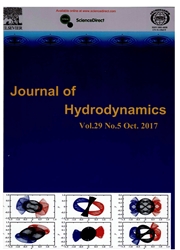

 中文摘要:
中文摘要:
大多数淡水鱼擅长转演习。一个模仿的鱼尾巴模型数字地详细被调查并且讨论。这研究处理在鱼尾巴鳍上施加在的不稳定的力量和时刻一起始斜着,击和随后的回来击打手势,并且设想流动领域和旋涡结构,鱼打手势以便探索典型拐弯处的流动控制机理。在相应于在它的 C 开始的鱼尾巴鳍的二张不同弯曲表格的动态后果被给的液体上推进讨论。Thetwo 维的不稳定的不可压缩的海军司烧方程与一个 developedpseudo 压缩的可能性方法被解决在鱼尾巴鳍附近模仿流动。有实验的计算结果和比较显示那( 1 )钓鱼用过程展览的往来活动的中风,和每个阶段生产的冲动的时刻执行它的身体的一个转弯的运动它的特定的水动力学特征,( 2 )鱼采用尾巴尖端拐弯(单个拐弯和两倍拐弯)的二张表格完成C开始拐弯处演习,在他们的物理状况和自然环境的依赖,( 3 )鱼能由 modulating 控制它的转弯的运动一些关键运动学的参数。
 英文摘要:
英文摘要:
Most freshwater fish are good at turning manoeuvres. A simulated fish tail model was numerically investigated and discussed in detail. This study deals with unsteady forces and moment exerted on the fish tail-fin in an initial sideways stroke and a subsequent return stroke motion, and visualizes the flow fields and vortex structures, in order to explore the flow control mechanism of the typical turning motion of fish. Further discussion on fluid dynamic consequences corresponding to two different bending forms of fish tail-fins in its C-start is given. The two-dimensional unsteady incompressible Navier-Stokes equations are solved with a developed pseudo-compressibility method to simulate the flow around the fish tail-fin. The computed results and the comparison with experiments indicate that (1) fish performs a turning motion of its body using the impulsive moment produced by the to-and-fro stroke, and each stage of the process exhibits its specific hydrodynamic characteristic, (2) fishes adopt two forms of tail-tip bend (single bend and double bend) to accomplish a C-start turning manoeuvre, in dependence of their physical situations and natural environments, (3) fish can control its turning motion by modulating some key kinematic parameters.
 同期刊论文项目
同期刊论文项目
 同项目期刊论文
同项目期刊论文
 期刊信息
期刊信息
